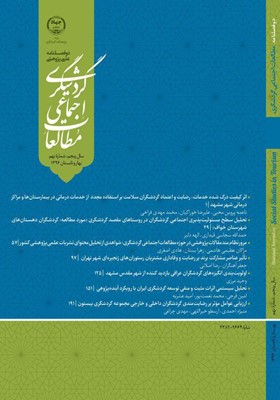تحلیل سیستمی اثرات مثبت و منفی توسعه گردشگری ایران با رویکرد آینده پژوهی
محورهای موضوعی :امین فرجی ملائی 1 , محمد نعمت پور 2 , امید عشریه 3
1 - دانشگاه تهران
2 -
3 -
کلید واژه: گردشگری اثرات اجتماعی فرهنگی اثرات اقتصادی اثرات زیست محیطی,
چکیده مقاله :
گسترش صنعت گردشگري علاوه بر ابعاد مثبت می تواند ابعاد منفی بسیاری نیز در زمینه های -اقتصادی، اجتماعی- فرهنگی و زیست محیطی در پی داشته باشد. مقاله حاضر با استفاده از روش تحلیل ساختاری، به مرور و تجزیه و تحلیل پژوهش های پیشین و نظرات کارشناسان پرداخته است. هدف اصلی این مقاله شناسايي و اولويت بندي اثرات مثبت و منفی گردشگری در مقياس ملی و در جریان روند توسعه گردشگری ايران است. این اثرات شامل اثرات اقتصادی (افزایش درآمد، ایجاد اشتغال، افزایش هزینه های زندگی، ایجاد تورم و غیره)، اثرات اجتماعی- فرهنگی (افزایش مشارکت و سرمایه اجتماعی، احیای ارزش های محلی، افزایش شکاف اجتماعی، مصرف گرایی و غیره) و اثرات زیست محیطی (بهبود کیفیت محیط، ترویج معماری سبز، کاهش سطح سرانه های طبیعی، کاهش ظرفیت تحمل فیزیکی و غیره) است. به منظور تجزیه و تحلیل داده ها از تحلیل سیستمی در محیط نرم افزار Micmac استفاده شده است. پژوهش حاضر ضمن ارائه و تنظیم مهم ترین عوامل تأثیرگذار و تأثیرپذیر در ابعاد اقتصادی، زیست محیطی و اجتماعی- فرهنگی، حاکی از آن است که برای رسیدن به یک سیستم پایدار در گردشگری توجه به اثرات منفی تأثیر گذار به ویژه در حوزه زیست محیطی در درجه اول اهمیت قرار دارد و در مرحله دوم می باید بر کاهش اثرات دو وجهی و ریسک به جهت غیرقابل پیش بینی بودن، تمرکز شود.
The rapid expansion of the tourism industry, besides positive aspects, can include many negative economic, socio-cultural and environmental issues. This paper, using structural analysis modeling, reviewed and analyzed the previous studies and experts’ opinions. The main purpose was to develop a model to identify and prioritize the influential positive and negative impacts of tourism on a national scale during tourism development process in Iran. The impacts include: (a) positive and negative economic impacts (including an increase in income, job generation, increasing the cost of living, inflation, etc.); (b) socio-cultural impacts (including an increase in social capital and participation, the revival of local values, increase in social gaps, consumerism, etc.); and (c) environmental impacts (including improving the quality of an environment, promoting the green architecture, reduction of natural per capita, reducing physical capacity, etc.). Structural analysis model was used to analyze the data using the Micmac software. The current study presented and arranged the most important influential and dependency factors in the economic, environmental and socio-cultural dimensions. The study pointed out that to reach a sustainable tourism system, the first priority is to concentrate on the influential negative impacts, especially on the environmental issues. The second priority is to focus on the reduction of the linkage and risk impacts due to their unpredictability.
